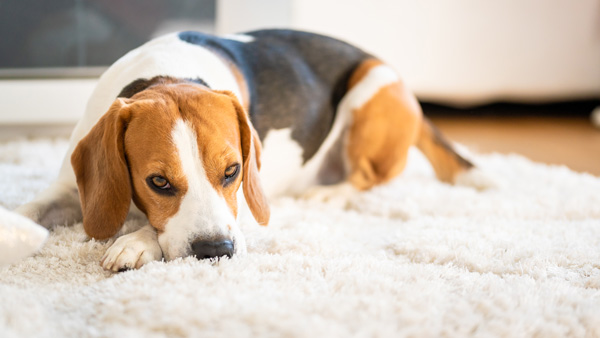What is hypothyroidism?
As with humans, hypothyroidism is caused by low levels of thyroid hormone being produced by the thyroid gland, which is located on either side of the throat. Since the thyroid gland is part of the endocrine system, any decrease in thyroid hormone secretion has an effect on multiple systems in the body that rely on hormones to function properly – like the metabolism.
What are the symptoms?
There are many different symptoms of hypothyroidism because thyroid hormones affect so many different parts of the body. Deterioration of the thyroid gland and its functioning are gradual and progressive, so the onset of symptoms may not be immediately noticeable. If your pet is displaying any or all of these symptoms, they could be linked to hypothyroidism:
- lethargy, inactivity or laziness
- weight gain
- mental dullness
- hair loss/excessive shedding/thinning of the coat
- dry and lustreless coat
- excessive scaling of the skin
- recurring skin infections
- hyperpigmentation (skin darkening)
- ear infections
- cold intolerance (manifests as heat-seeking behaviour)
Sometimes hypothyroidism can also be associated with any of the following: generalised weakness, incoordination, head tilt, facial paralysis, seizures and infertility.
Which pets are more likely to be affected by hypothyroidism?
Hypothyroidism in cats is rare and is usually caused when the thyroid gland is removed or by the over-treatment of hyperthyroidism.
Hypothyroidism is common in medium to large breed dogs, with the average age of diagnosis being between the ages of four and 10 years old. Some breeds are more predisposed to developing hypothyroidism, such as golden retrievers, Doberman pinschers, Irish setters, Great Danes, Airedale terriers, dachshunds, Old English sheepdogs, miniature and giant schnauzers, cocker spaniels, poodles and boxers. Sterilised dogs have a higher risk of developing hypothyroidism, but vets are unsure why this is the case – it certainly is not a reason to not sterilise your pet!
What causes hypothyroidism?
Approximately 95% of hypothyroidism in dogs is caused by outside factors that have a negative influence on the thyroid. Very rarely are animals born with a faulty thyroid; similarly, it’s also rare for hypothyroidism to be the result of thyroid cancer. Many cases of hypothyroidism are ‘immune-mediated’ or caused by the immune system attacking the thyroid gland (lymphocytic thyroiditis), while in other cases, thyroid tissue is replaced by fat tissue (idiopathic thyroid atrophy).
Secondary acquired hypothyroidism, which is also rare, is caused by a dysfunction of the pituitary gland, which secretes thyroid stimulating hormone (TSH) and affects how the thyroid gland produces thyroid hormones.
What will my vet look for if hypothyroidism is suspected?
Hypothyroidism influences several body systems including the metabolic, skin, behavioural, neuromuscular, reproductive, gastrointestinal, ophthalmic, cardiovascular, and nervous systems. The vet will thus need to piece together a rather complicated puzzle made up of the pet’s history, the symptoms they are showing, the vet’s own examination and blood tests. To rule out thyroid tumours, the vet may take an X-ray. The blood tests will reveal low thyroid hormones in the blood, non-regenerative anaemia, and sometimes high levels of TSH. Most dogs with hypothyroidism will also have high levels of cholesterol, while half will have anaemia.
The vet will also look for thickening of the skin, which – when it occurs around the face – causes a sagging face and a sad or ‘tragic’ expression.
Can hypothyroidism be treated?
Unfortunately, hypothyroidism is an endocrine condition, which cannot be cured – it can only be managed, which must go hand-in-hand with a good quality of life for the affected pet. Managing hypothyroidism successfully relies on care in these four pivotal areas:
i. Diet
The pet’s diet must be properly managed to lower their weight until they reach a good body weight and thyroid hormone levels reach the normal range. Different pets will have different dietary needs, which is why it’s important to follow the vet’s recommendations and to give the affected pet a prescription diet to help with weight management.
ii. Client education
Pet owner education is critical in successfully managing hypothyroidism. You as the pet owner have to understand that treatment will be life-long, which means an additional commitment to your pet for the rest of their life. When treatment begins, some symptoms may worsen before they improve, and may take between a few weeks to a few months to resolve, but don’t panic and please be patient. It’s important to stick to the recommended treatment as it will help in the long run. Abandoning the treatment prematurely will further reduce your pet’s quality of life.
iii. Drugs
The use of medication is the easiest part in the treatment of hypothyroidism. The prescribed medication includes thyroid hormone substitutes. They need to be given daily for the rest of your pet’s life, at the vet’s recommended dosage. Any additional drugs would be used to manage any of the other symptoms, such as controlling skin infections.
iv. Follow-up
Since hypothyroidism needs life-long management, routine follow-ups will be necessary, if not mandatory. Expect frequent follow-ups in the early stages of treatment, but as your pet’s symptoms begin to respond positively to treatment, these vet visits will become less frequent. In future follow-ups, the vet will examine the symptoms and perform blood tests to see how your pet’s hormone levels are responding, then adjust the medication and other therapies accordingly.
Conclusion
It may be stressful to see pets suffering from the symptoms of hypothyroidism, but once diagnosed, this condition is not a death sentence. It requires your commitment to proper treatment and giving your pet a great quality of life, all with the help of the vet and keeping them up to speed with your pet’s progress.
© 2020 Vetwebsites – The Code Company Trading (Pty) Ltd


